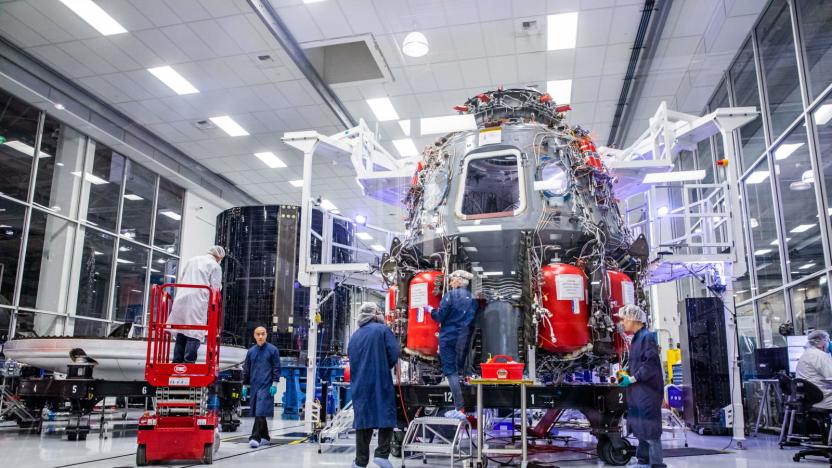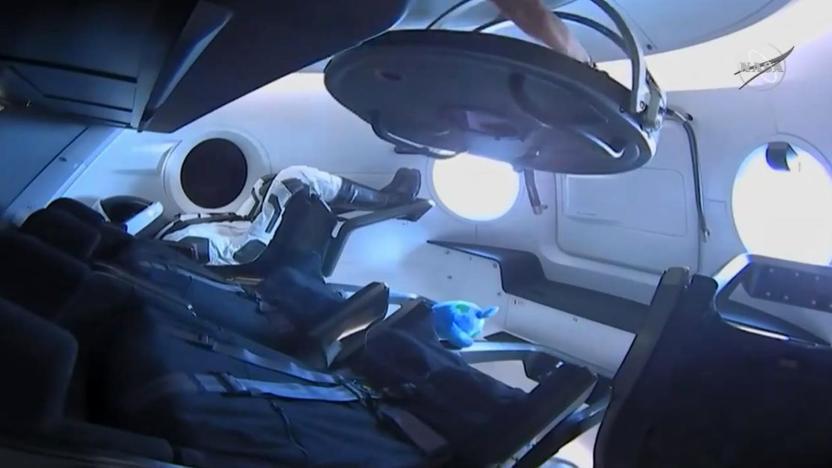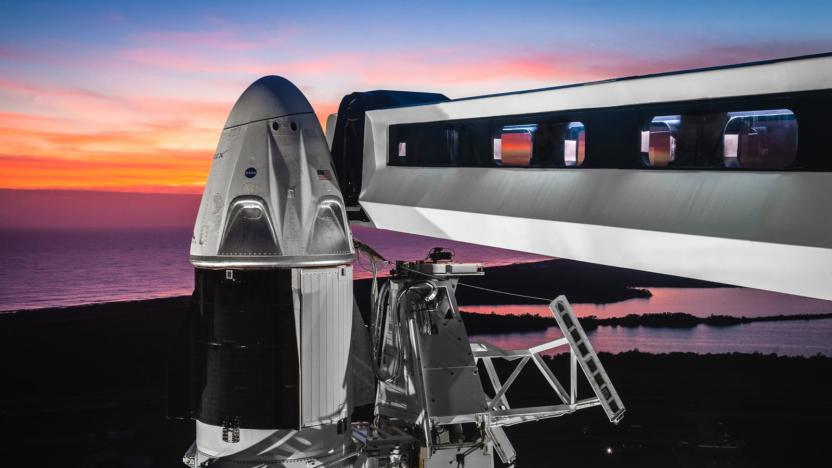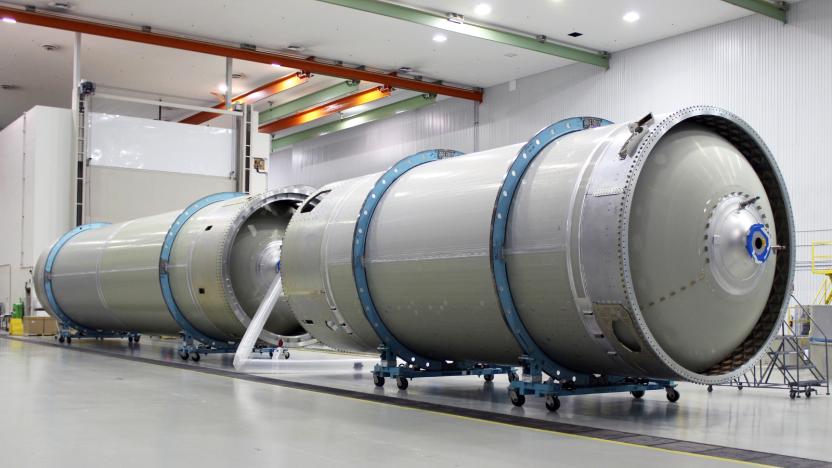commercialcrewprogram
Latest

SpaceX's next Crew Dragon test could happen next week
SpaceX is reportedly gearing up for the next test of its Crew Dragon capsule. A static fire test (a simulated launch with a rocket engine secured to the ground) is set to take place at Cape Canaveral Air Force Station in Florida November 2nd, according to CNBC. Engadget has contacted SpaceX for comment.

SpaceX Crew Dragon capsule docks with ISS
SpaceX's Crew Dragon has completed the last leg of its historic first journey. The capsule docked with the International Space Station through a "soft capture" at 5:51AM Eastern, with astronauts aboard the ISS opening the hatch shortly after 8AM. There wasn't much to greet the ISS crew this time around, as the test flight only included 400lbs of supplies and the human-shaped Ripley test device. Still, it's an important moment in NASA's Commercial Crew Program -- an American capsule has docked in orbit.

SpaceX postpones first Crew Dragon flight until March 2nd
SpaceX and NASA have set a new target date for the Crew Dragon's first test flight: March 2nd. The capsule was supposed to blast off on top of a Falcon 9 rocket and head to the ISS for the first time on January 7th, but the partners rescheduled it twice since then. Neither gave an explanation for the delays -- they're pretty common when it comes to rocket launches, after all -- but Florida Today brought up the possibility that the capsule's first test was affected by the 35-day government shutdown that lasted until January 25th.

SpaceX test firing sets path for Crew Dragon flight in February
On Thursday afternoon the rocket engines under SpaceX's Crew Dragon vehicle briefly fired up, and after a few delays the company said on Twitter that it's planning for a test flight in February. You can watch a video of the test below, which according to CBS reporter William Harwood, may have been a bit shorter than planned and could lead to a retest. Anonymous sources indicated that the test flight is tentatively scheduled for February 23rd. As Ars Technica notes, while SpaceX and Boeing prepare their vehicles for testing, NASA personnel with the commercial crew program are currently working without pay in support due to the ongoing government shutdown.

NASA and SpaceX reschedule the first crew capsule test flight
We're a few weeks away from the first uncrewed Demo-1 flight test to the Space Station, but NASA and SpaceX have pushed the mission back slightly. According to a post from the Commercial Crew Program, switching the date back ten days from January 7th to January 17th will allow time for the Dragon capsule to return from its 16th ISS supply run (if you're quick, you can catch the spacecraft docking live this morning, two days after it launched). Its competition, Boeing's Starliner, is scheduled for a test in March. Getting this test done to gather data and test the in-flight abort function ahead of a flight with the Crew Dragon capsule that carries astronauts onboard is critical, as Commercial Crew Program manager Kathy Lueders said "The upcoming steps before the test missions are critical, and their importance can't be understated. We are not driven by dates, but by data. Ultimately, we'll fly SpaceX Demo-1 at the right time, so we get the right data back to support the in-flight abort test and the next test flight when our astronauts are aboard."

The new space race is postponed until 2018
Aboard the International Space Station, an A4-size flag of the United States hangs next to a 1:100 model of a space shuttle. The memento, placed there by the last crew to fly on shuttle Atlantis, is meant to be retrieved by the next batch of astronauts that launches on a US spacecraft. NASA had hoped to reach that goal in 2017 after awarding Boeing and SpaceX billion-dollar contracts under the Commercial Crew Program (CCP). However, the road back to manned missions is paved with thorns and technical challenges. We certainly won't see any astronauts ferried to Low Earth Orbit before the year ends, but both companies believe that 2018 is the year that flag will be returned to Earth.

Boeing builds towards its first space taxi test
When NASA first named Boeing and SpaceX as recipients of the Commercial Crew Program, they originally aimed to end the agency's dependence on Russia by 2017. But developing space technologies is hard, and both companies had to push their first crewed test flights to late 2018 -- some reports even say they'll be delayed until 2019. While it's still unclear when we'll see the first space taxi blast off, Boeing has at least begun putting together the Atlas V rocket that will ferry the CST-100 Starliner taxi to orbit for the very first time.

New NASA budget focuses almost exclusively on space
Congress has finally passed a bill authorizing NASA's new budget that gives the agency annual funding of$19.5 billion. The paperwork remains mostly unchanged from when it was passed in the Senate last December, with only minor alterations being made. The NASA Transition Authorization Act of 2017 was passed without opposition and focuses almost exclusively on space travel and science. Details about the agency's more contentious Earth-based research, however, will have to wait another day.

NASA tests battle trucks as astronaut escape vehicles
If something goes catastrophically wrong during one of NASA's upcoming commercial spacecraft launches, the crew will need to get clear of the launchpad -- and fast. But they won't be doing so in the lumbering old M113 Armored Personnel Carriers that they used during the Shuttle era. Heck no; if these Mine-Resistant Ambush Protected vehicles are good enough for the LAUSD, they're damn well suitable for our astronauts.

SpaceX tests the safety rockets for its manned space vehicles
NASA's Commercial Crew Program is an initiative to get private companies to ferry personnel to-and-from the International Space Station. SpaceX is doing its very best to show that it can do the job, and has successfully tested one of the most important components its crewed vehicle needs: the escape engine. The company has test-fired a pair of its SuperDraco engines in Texas, demonstrating that the gear could ignite and throttle at the same time.

Boeing and SpaceX schedule crucial safety tests ahead of ISS trips
SpaceX and Boeing spoke together in public for the first time with NASA and unveiled their plans to ferry astronauts to the International Space Station (ISS) in 2017. NASA selected the companies last September to build manned spacecraft for its Commercial Crew Program, and both have tight schedules to make. A crucial phase will be the so-called pad abort tests, which "provide astronauts a means of escaping a potentially catastrophic situation," according to NASA. Boeing will run its pad abort tests in February 2017, with an uncrewed flight test in April and a full mission with a test pilot and NASA astronaut slated for July, 2017. Meanwhile, SpaceX's pad abort test and in-flight abort test are scheduled for later this year, with a manned trip planned for 2017.

Jeff Bezos' Blue Origin has struck a deal with Boeing and Lockheed to build space rockets
Wondering why NASA gave Boeing the lion's share of its space taxi funding? Jeff Bezos could have something to do with it. Shortly after NASA awarded Boeing $4.2 billion in funding, the Wall Street Journal claimed the company padded its bid with a partnership with Bezos' Blue Origin. Turns out, the WSJ was right: today Blue Origin and the United Launch Alliance (a joint venture of Boeing and Lockheed Martin) entered an agreement to fund and build the Blue Origin BE-4 rocket engine. Basically, Boeing is going to build NASA's space taxi capsules and Bezos' rocket company is going to launch them out of our atmosphere.

Boeing and SpaceX will shuttle American astronauts to the ISS
There had been rumors of NASA awarding Boeing a big contract for its Commercial Crew Program, and it turns out that the claims were true -- and then some. The agency has just announced that both Boeing's CST-100 capsule and SpaceX's Dragon V2 will ferry American astronauts to the International Space Station from 2017 onward. Most of the funding ($4.2 billion) will go to Boeing's entry, but the SpaceX deal is still pretty hefty at $2.6 billion. Once both vehicles are certified and tested, they'll participate in manned scientific missions (up to six each) and serve as lifeboats in emergencies. Unfortunately, Sierra Nevada's aircraft-like Dream Chaser isn't part of the picture. It's ultimately a good day for space travel, but those hoping for a Space Shuttle-like design will be disappointed.

Boeing is expected to build most of NASA's space taxis (update: official)
NASA may have been even-handed when it started doling out money to contractors for its space taxi program, but there are hints that it's about to play favorites. The Wall Street Journal hears from anonymous officials that Boeing is now the odds-on favorite to get the majority of NASA's astronaut transportation business. SpaceX, once thought to be the frontrunner, would be relegated to a "second source" alongside Sierra Nevada. Reportedly, the agency sees Boeing's CST-100 capsule as the easy choice -- it carries relatively few risks, and is more likely to be ready for business in three years than SpaceX's Dragon V2. Update: Sure enough, NASA announced its contracts today. Boeing will get the lion's share of the business with $4.2 billion in funding, but SpaceX isn't exactly a bit player here -- it's getting $2.6 billion. Sierra Nevada's Dream Chaser won't be part of the picture, however.

Boeing, SpaceX win NASA 'space taxi' funding race (updated)
NASA has reportedly picked Boeing and SpaceX as the two companies to receive primary funding for the "Commercial Crew Program." The news was reportedly leaked to NBC News' Jay Barbree, but all parties involved have refused to comment until NASA makes the official announcement later today. While Boeing and SpaceX are likely to take home the bulk of $1 billion in funding, Sierra Nevada has been picked as the "standby" candidate -- with a mandate to step in if either primary partner fails. If true, then it means that Jeff Bezos' Blue Origin has been cut out of the race entirely -- although disappointment is easier to take if you're a billionaire... we've heard. Update: NASA's confirmed its picks, with back-up choice Sierra Nevada picking up $212.5 million, while Space X and Boeing got $440 million and $460 million, respectively. To celebrate, SpaceX's crafted another stargazing video -- it's right after the break.

Congress, NASA agree to thin out commercial spaceflight partners for 'space taxi' program
Congress has twisted NASA's arm on a new deal for the "Commercial Crew Program," designed to get private spaceflight companies to ferry astronauts into space. Senator Representative Frank Wolf wants NASA to scale back its grants to four companies: SpaceX, Boeing, Blue Origin and Sierra Nevada down to two, while a third gets a retainer in case one of those chosen pair fails. The administration will be examining the financial health and business viability of each company before doling out the cash -- with one of those named above effectively being shut out of the market. Although, we imagine SpaceX did itself no harm at all when it became the first commercial enterprise to get a capsule to the ISS.







